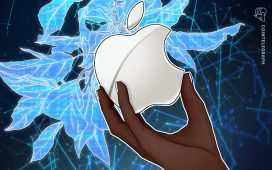Sign up for the Slatest to get the most insightful analysis, criticism, and advice out there, delivered to your inbox daily.
One of the best shows on TV returns this week. You have probably not seen it, because it runs on a tiny platform run by a would-be disruptor that hasn’t been able to dent a field dominated by giants.
That’s right: It’s Apple TV+, and on Friday, it brings back Severance for a second season. The sci-fi thriller from creator Dan Erickson is an amazing piece of TV, one of those triumphs of world-building that leaves you shaking and racing to Reddit to read theories as soon as an episode ends. Severance debuted in 2022 and is only just now returning after substantial production delays. It follows workers at a megacorporation who submit to a procedure that severs their work memories from their personal ones, and it gets wildly weird. The new season, which I’ve seen most of, is a worthy follow-up to the first.
Severance is not alone among strong Apple TV+ sci-fi or strong Apple TV+ shows in general. For my $9.99, this service is an indispensable streamer these days, the gateway not just to Severance but to Slow Horses, For All Mankind, and a handful of others. No platform has a better ratio of things I watch to things I finish—and actually enjoy—than this one.
I am in the minority. Though its parent company might have ambitions for the service that are more complex than winning the streaming wars, it is clear that Apple TV+ is losing them in a lopsided fashion. According to Nielsen data, well under 1 percent of all TV screen time in the United States is spent on Apple TV+ in any given month. (About 0.3 percent is typical. YouTube, the king, is above 10 percent, while Netflix is around 8 percent, Prime Video 4 percent, and Hulu 3 percent.) Apple TV+ is so far down the list of streamers by watch time that Nielsen relegates it to the “other streaming” category of a pie chart.
It’s odd. Apple is the most ubiquitous company around, with a theoretical billboard for its streaming service sitting in most of our pockets at all times. Yet Apple cannot get a bite from the streaming public, seemingly no matter how much money it spends on any number of quality shows. I have decided that Apple TV+’s issues are the result of a weird thing to say about an Apple product: The service is just a bit too pure for this world.
Apple has never released subscriber figures for its streamer. That number might not be illuminating anyway, because the company has given away lots of subscriptions. If you have bought certain Apple products in the past few years, you have gotten some free months of Apple TV+. If your favorite baseball team had a game on Apple TV+, you could get some free months of Apple TV+ to watch that one game. (You could even do this if you were a former subscriber who had taken a break.) If you did nothing at all but were at home on the first weekend of the year, you could at least get Apple TV+ free for a few days.
Freebies aren’t the only idea Apple has tried to get more people onto the service. It also followed the same strategy as most of its would-be competitors. Live sports are perhaps the easiest way for a huge company to drive subscribers to a streamer. (See Peacock’s use of the NFL playoffs and Olympics.) Apple hasn’t gotten any properties that big, and one of its bigger bids, the one for the Pac-12, didn’t work out. Weekly Major League Baseball games last year did not lift it out of the viewership basement. Apple’s partnership with Major League Soccer, which now puts every game on a special paywalled product within Apple TV+, has been pretty good for MLS, all things considered. Yet Apple TV+ continues to languish at the bottom of the pecking order.
Its sports portfolio aside, Apple TV+ has an excellent selection of shows. A few have caught cultural fire, most of all Ted Lasso, a sports sitcom with a heavy dose of mental health drama. The Morning Show has done well enough to briefly get into the top 10 most-watched streaming shows. Silo, a post-apocalyptic drama about people living in an underground tube, has done some big numbers. So has Shrinking, a mental health dark comedy of sorts that shares a star and writer (Brett Goldstein) with Lasso. These shows have each cost many millions of dollars, all with impeccable sets and production value. They also have huge stars anchoring them: some Harrison Ford here, some Jennifer Aniston there, some Jason Sudeikis or Reese Witherspoon there. In a vacuum, you would think they’d all be blockbusters. Yet Apple TV+, in raw viewership terms, continues to flail.
Nobody will ever feel bad for Apple, which is less an edgy, independent producer and more the most powerful company in the world trying to grab a slice of the streaming ecosystem to pad its reputation or, one day, its margins. Being part of the most giant of tech giants has sometimes limited the good work Apple TV+ has done. Tim Cook reportedly intervened to stop a show about the death of Gawker, a website that offended him personally. Jon Stewart’s latest talk show ended because it wasn’t palatable for him to talk freely about geopolitics on a service operated by a company that sells lots of iPhones in China.
But let us assume that the American public isn’t passing on Apple TV+ because of a principled objection to Big Tech’s control over storytelling. Seemingly everyone has an idea about why the service hasn’t caught on more. If there were one silver-bullet answer to the question of why more people aren’t watching, then Apple, which sits atop of a pile of many billions of dollars in cash, would have found it by now.
The service barely has a library. You can scroll through all of Apple TV’s couple of hundred shows and movies in a matter of seconds. Most tech media have surmised that this small library is a disadvantage, and I’m sure they’re right: Apple just doesn’t have an endless pile of titles to algorithmically throw users into as soon as they’re done with whatever they’re watching. But I have quite enjoyed the platform’s small selection, because it spares me from the paralysis of endless choice that drowns me on Netflix.
Other factors abound. Apple TV+ doesn’t get nearly the marketing push that Apple’s hardware gets, a disparity that’s drawn the attention of entertainment journalists. The service’s shows are great, but you may have noticed the lack of any discussion in this story about feature-length films. That is because Apple’s forays into film have been somewhere between “fine” and “commercially and critically disastrous,” as when spy movie Argylle bombed in 2024. Then there is the simple matter of price. Apple TV+ is competitive at $9.99 a month, especially for a service that remains (for now, anyway) ad-free. But $9.99 is more than the old $4.99 and $6.99, and no streamer is immune to people bailing as it hikes the price.
If the company at issue here were not literally Apple, this streaming service would be a sympathetic player. I want a streamer that doesn’t confuse me with a deluge of titles I’ll never watch, shuffling me algorithmically from one to the next faster than I can tell what is happening. I want a streamer that does not mind spending tens of millions of dollars on untested properties, rather than intellectual property reboots. (Hollywood’s economy could use it.) I want a streamer that isn’t fully bound to reality programming as a low-cost way to keep eyeballs. That may all be too much to ask for in the long term, but for now I will settle for something more modest. I would like enough people to watch Severance that I can have a proper group chat about it before some cost-cutter in Cupertino asks what’s going on.











